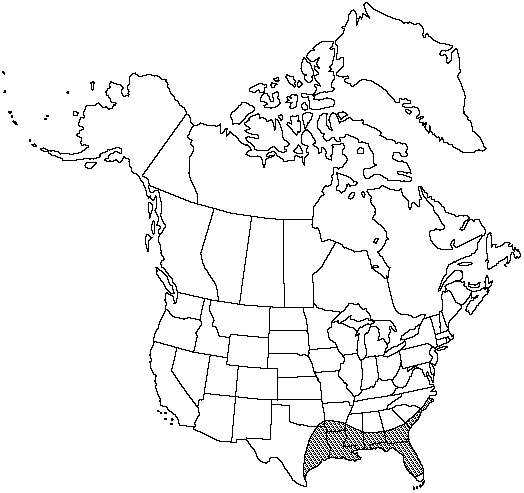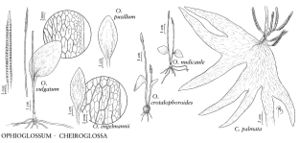Difference between revisions of "Ophioglossum nudicaule"
Suppl. Pl. 443. 1781.
FNA>Volume Importer |
imported>Volume Importer |
||
| (7 intermediate revisions by 2 users not shown) | |||
| Line 8: | Line 8: | ||
}} | }} | ||
|common_names=Slender adder's-tongue | |common_names=Slender adder's-tongue | ||
| + | |special_status={{Treatment/ID/Special_status | ||
| + | |code=F | ||
| + | |label=Illustrated | ||
| + | }} | ||
|basionyms= | |basionyms= | ||
|synonyms={{Treatment/ID/Synonym | |synonyms={{Treatment/ID/Synonym | ||
|name=Ophioglossum dendroneuron | |name=Ophioglossum dendroneuron | ||
|authority=E.P. St.John | |authority=E.P. St.John | ||
| − | }}{{Treatment/ID/Synonym | + | |rank=species |
| + | }} {{Treatment/ID/Synonym | ||
|name=Ophioglossum ellipticum | |name=Ophioglossum ellipticum | ||
|authority=Hooker & Greville | |authority=Hooker & Greville | ||
| − | }}{{Treatment/ID/Synonym | + | |rank=species |
| + | }} {{Treatment/ID/Synonym | ||
|name=Ophioglossum mononeuron | |name=Ophioglossum mononeuron | ||
|authority=E.P. St.John | |authority=E.P. St.John | ||
| + | |rank=species | ||
}} | }} | ||
|hierarchy=Ophioglossaceae;Ophioglossum;Ophioglossum nudicaule | |hierarchy=Ophioglossaceae;Ophioglossum;Ophioglossum nudicaule | ||
| Line 26: | Line 33: | ||
}}<!-- | }}<!-- | ||
| − | --><span class="statement" id="st- | + | --><span class="statement" id="st-undefined" data-properties=""><b>Roots </b>yellowish to pale brown, to 15 per plant, 0.2-0.8mm diam., proliferous at wide intervals. <b>Stem</b> upright, 0.2-1.2 cm, 1-5 mm diam., commonly 2-3 leaves per stem. <b>Trophophore</b> stalk to 0.8 cm, 0.1-0.2 times length of trophophore blade. <b>Trophophore</b> blade spreading, usually plane when alive, green, dull, largest leaves drying with pale central band, ovate to lanceolate, thin, blades less than 0.4 × 0.3 cm in many colonies but blades large, to 4.5 × 1.7 cm in other colonies, herbaceous, base gradually tapered, apex with short apiculum; venation finely complex-reticulate, areoles with only included veinlets in smaller blades but with numerous secondary areoles in largest blades. <b>Sporophores</b> arising at or near ground level, 2-6 times as long as trophophore; sporangial clusters 0.5-1.5cm, 1.5 mm or less wide, mostly with 5-12 pairs of sporangia, apiculum 0.5-1 mm.</span><!-- |
-->{{Treatment/Body | -->{{Treatment/Body | ||
| + | |phenology=Leaves appearing in latter half of winter and early spring, sometimes with second flush in same year after heavy rains. | ||
|habitat=Second-growth fields, vacant lots, roadside ditches, and lawns | |habitat=Second-growth fields, vacant lots, roadside ditches, and lawns | ||
|elevation=0-90 m | |elevation=0-90 m | ||
|distribution=Ala.;Ark.;Fla.;Ga.;La.;Miss.;N.C.;Okla.;S.C.;Tex.;Mexico;West Indies;Central America;South America;Asia;Africa;Pacific Islands. | |distribution=Ala.;Ark.;Fla.;Ga.;La.;Miss.;N.C.;Okla.;S.C.;Tex.;Mexico;West Indies;Central America;South America;Asia;Africa;Pacific Islands. | ||
| − | |discussion=<p>Ophioglossum nudicaule is much less common than O. crotalophoroides; they often occur together and are found in the same or similar habitats. The gametophytes of O. nudicaule are typical for the genus (M.R. Mesler et al. 1975). A given colony may be made up of small, medium, or large plants (W.H. Wagner Jr., C. M. Allen, and G.P. Landry 1984).</p> | + | |discussion=<p><i>Ophioglossum nudicaule</i> is much less common than <i>O. crotalophoroides</i>; they often occur together and are found in the same or similar habitats. The gametophytes of <i>O. nudicaule</i> are typical for the genus (M.R. Mesler et al. 1975). A given colony may be made up of small, medium, or large plants (W.H. Wagner Jr., C. M. Allen, and G.P. Landry 1984).</p> |
|tables= | |tables= | ||
|references= | |references= | ||
| Line 41: | Line 49: | ||
-->{{#Taxon: | -->{{#Taxon: | ||
name=Ophioglossum nudicaule | name=Ophioglossum nudicaule | ||
| − | |||
|authority=Linnaeus | |authority=Linnaeus | ||
|rank=species | |rank=species | ||
| Line 48: | Line 55: | ||
|basionyms= | |basionyms= | ||
|family=Ophioglossaceae | |family=Ophioglossaceae | ||
| + | |phenology=Leaves appearing in latter half of winter and early spring, sometimes with second flush in same year after heavy rains. | ||
|habitat=Second-growth fields, vacant lots, roadside ditches, and lawns | |habitat=Second-growth fields, vacant lots, roadside ditches, and lawns | ||
|elevation=0-90 m | |elevation=0-90 m | ||
| Line 54: | Line 62: | ||
|publication title=Suppl. Pl. | |publication title=Suppl. Pl. | ||
|publication year=1781 | |publication year=1781 | ||
| − | |special status= | + | |special status=Illustrated |
| − | |source xml=https:// | + | |source xml=https://bitbucket.org/aafc-mbb/fna-data-curation/src/2e0870ddd59836b60bcf96646a41e87ea5a5943a/coarse_grained_fna_xml/V2/V2_825.xml |
|genus=Ophioglossum | |genus=Ophioglossum | ||
|species=Ophioglossum nudicaule | |species=Ophioglossum nudicaule | ||
| − | |||
| − | |||
| − | |||
| − | |||
| − | |||
| − | |||
| − | |||
| − | |||
| − | |||
| − | |||
| − | |||
| − | |||
| − | |||
| − | |||
| − | |||
| − | |||
| − | |||
| − | |||
| − | |||
| − | |||
| − | |||
| − | |||
| − | |||
| − | |||
| − | |||
| − | |||
| − | |||
| − | |||
| − | |||
| − | |||
| − | |||
| − | |||
| − | |||
| − | |||
| − | |||
}}<!-- | }}<!-- | ||
-->[[Category:Treatment]][[Category:Ophioglossum]] | -->[[Category:Treatment]][[Category:Ophioglossum]] | ||
Latest revision as of 20:25, 5 November 2020
Roots yellowish to pale brown, to 15 per plant, 0.2-0.8mm diam., proliferous at wide intervals. Stem upright, 0.2-1.2 cm, 1-5 mm diam., commonly 2-3 leaves per stem. Trophophore stalk to 0.8 cm, 0.1-0.2 times length of trophophore blade. Trophophore blade spreading, usually plane when alive, green, dull, largest leaves drying with pale central band, ovate to lanceolate, thin, blades less than 0.4 × 0.3 cm in many colonies but blades large, to 4.5 × 1.7 cm in other colonies, herbaceous, base gradually tapered, apex with short apiculum; venation finely complex-reticulate, areoles with only included veinlets in smaller blades but with numerous secondary areoles in largest blades. Sporophores arising at or near ground level, 2-6 times as long as trophophore; sporangial clusters 0.5-1.5cm, 1.5 mm or less wide, mostly with 5-12 pairs of sporangia, apiculum 0.5-1 mm.
Phenology: Leaves appearing in latter half of winter and early spring, sometimes with second flush in same year after heavy rains.
Habitat: Second-growth fields, vacant lots, roadside ditches, and lawns
Elevation: 0-90 m
Distribution

Ala., Ark., Fla., Ga., La., Miss., N.C., Okla., S.C., Tex., Mexico, West Indies, Central America, South America, Asia, Africa, Pacific Islands.
Discussion
Ophioglossum nudicaule is much less common than O. crotalophoroides; they often occur together and are found in the same or similar habitats. The gametophytes of O. nudicaule are typical for the genus (M.R. Mesler et al. 1975). A given colony may be made up of small, medium, or large plants (W.H. Wagner Jr., C. M. Allen, and G.P. Landry 1984).
Selected References
None.
